It’s the first ‘proper’ motorbike from electric urban mobility specialists Vmoto. We spent a few days round London on the new Vmoto Stash to see how it stacks up!
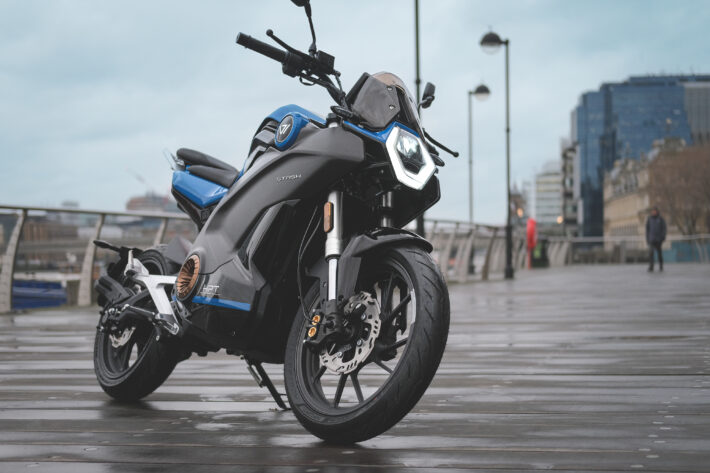
Bike journalists like me don’t often ride restricted 125cc learner bikes. We’ll do the odd group test every few years, maybe, and a press launch now and again.
But generally, we’re spending most of our time on bikes with ten times the power (or more) of the 15bhp L-plate machines most people get their licenses on. (Or not – plenty of delivery riders and commuters stick to 125s, L-plates and CBT renewals for their entire riding life.)
Which means that it’s a bit of a shock when you do finally put a leg over a 125cc machine – even a modern one. The engines are wheezy and vibey, the clutch and gearbox often agricultural and basic: the entire powertrain experience of a 125cc four-stroke single-cylinder motor sucks, generally.
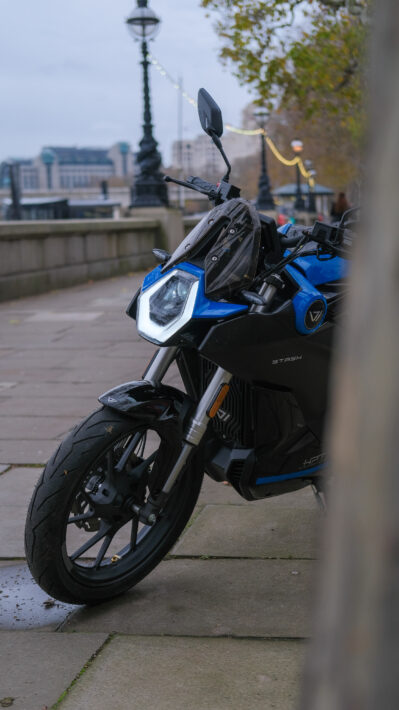
But riding this 125-class machine through the badlands of Kingston upon Thames today, I’m having a very different experience. Strong, grunty drive straight off the line, smooth acceleration, no grabby clutch or notchy gearchange.
That’s because there’s no internal combustion taking place between my legs today: rather, it’s electrons that are getting me going, in the form of the new Vmoto Stash, a battery-powered electric 125-class bike.
It’s the first ‘proper’ motorbike design from the Australian/Chinese/European brand, which has been at the top of the UK electric bike sales charts for years now. Vmoto, or Super Soco as it was also known, made its name selling no-nonsense battery-powered urban mobility tools to commuters and delivery drivers.
You’ve probably seen its steeds bringing you pizza on a Friday night. And while that’s not a very sexy sector, it is one that sorts out the men from the boys, in terms of reliability, usability and practicality.
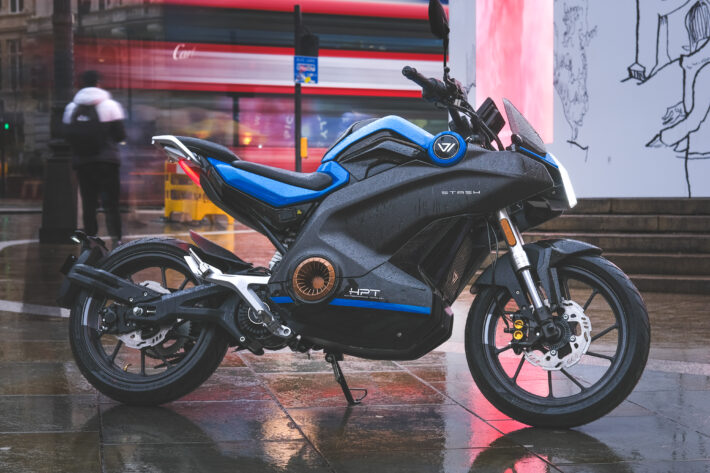
These machines get a hard life, and it’s testament to Vmoto’s engineering that they stand up so well to constant fleet use in big cities.
Which brings us to this, the Stash. First off, the slightly silly name comes from the useful helmet-sized lockable storage space in the ‘fuel tank’ in front of the rider’s seat.
That innovation is joined by the mid-mounted electric motor, rather than the hub motor used on Vmoto’s other bikes, which is an easier option for lower-performance machinery.
The mid-mount power unit has a proper chain final drive, with the handling and suspension advantages that come from not having the weight of the motor bouncing up and down with the back wheel.
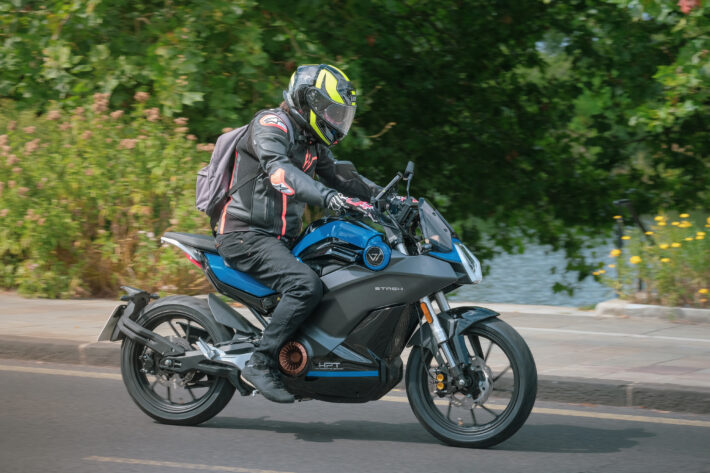
The motor itself has a rated continuous output of around 12bhp, but peak output of nearly 20bhp, a bit of a loophole compared with petrol engines that only have one power rating, and part of the reason for the peppy performance.
It’s all powered by a single fixed battery pack behind the swoopy main fairing, with a 90 mile claimed range, and 74v/97Ah rated capacity. It charges up with the supplied 1.7kW charging unit, which connects using a proprietary socket on the bike’s sidepanel and plugs into a normal 13A domestic mains socket.
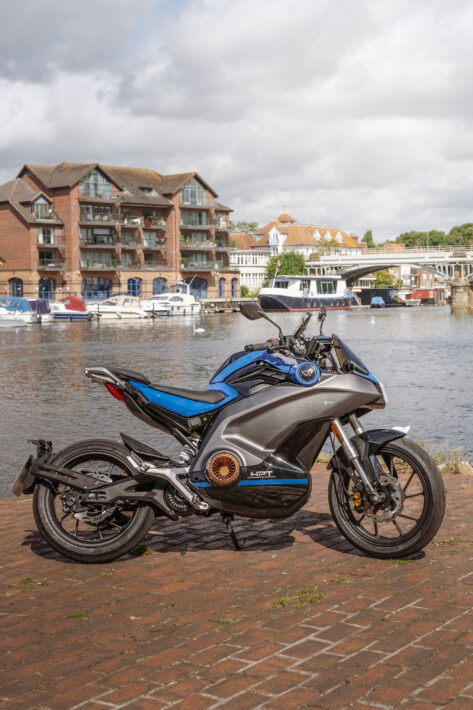
Full 0-100% charging takes a claimed five hours, but much of that time is getting the last 20 percent. In daily commuting use, if you’re charging at home and at work, you should generally have plenty of charge, with a bit of planning.
The chassis is standard 125cc fare: a monoshock rear suspension setup with basic USD forks, and a steel tube frame. The brakes are sharp though: a four-piston radial-mount front caliper on a single disc, with a proper dual channel ABS setup.
And Vmoto has avoided a common mistake by smaller brands – they’ve fitted proper Pirelli Diablo Rosso tyres rather than some second- or third-division brand. A proper premium tyre makes all the difference to a chassis, though as we’ll find out later, the Stash has other limitations to its handling which eclipses the tyre situation somewhat.
The bodywork is pretty sweet as well: it’s penned by designer Adrian Morton, better known for the Benelli Tornado and various MV Agusta superbikes than an electric learner bike.
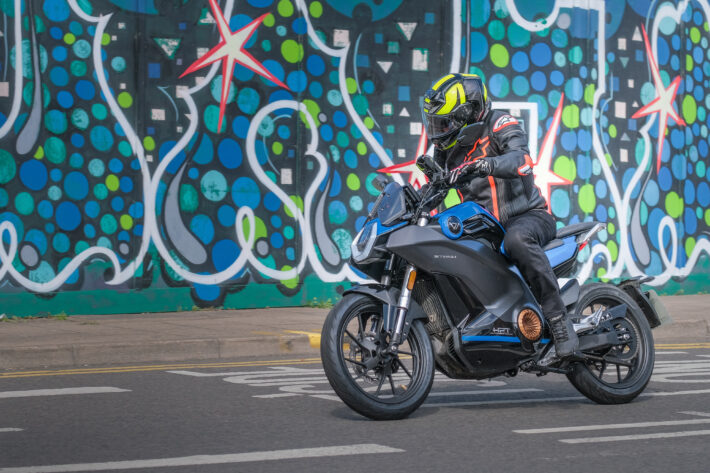
He’s come up with the Ducati 999-style aerodynamic-looking dual-layer slab-side main fairing panels, and the futuristic gold ‘hub’ design cue near the motor unit, and the result is a cut above most non-‘big’ brand learner bikes (and even some mainstream designs).
That’s the spec then, but what is the Stash like to ride? Pretty good is the answer.
It arrived at my house fully charged in a van, so I got to go full beans right away, starting off with a ride through Sutton and Cheam in London, towards Kingston. It’s easy to get going: unlock the manual steering lock on the bottom yoke with the key, ignition on with the handy keyless remote, and it pings into life.
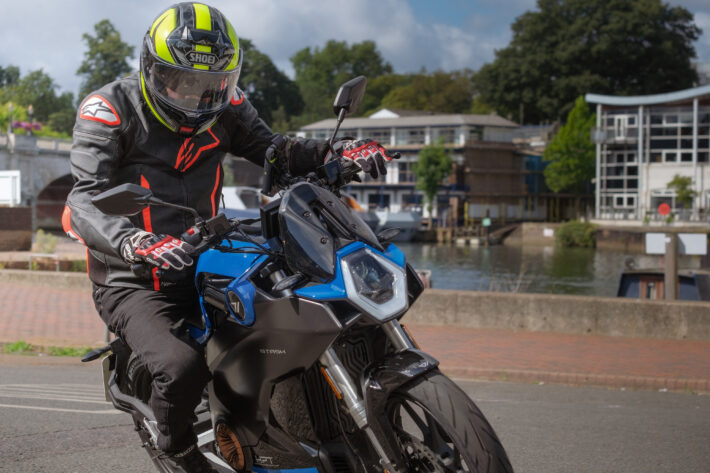
The dash is huge, bright and colourful, with loads of info, and various modes. Sidestand up, kill-switch off, and you’re ready to roll. The silence is of course disconcerting at first, but the little Vmoto doesn’t mess about off the line.
My ace photographer for the day, Tom, is on his Ducati 848, so has an excess of horsepower, but the Stash still gets the odd holeshot away from the lights. As soon as you whip the throttle twistgrip round, the back wheel provides instant drive, and with no gears or clutch to manage, there’s zero interruption to the thrust.
Okay, it’s still only a sub-20bhp output, and a rough count suggests a 0-60 time of 5-6 seconds, so once you’re moving, big bikes and sporty cars will easily pass you. But compared with buses, trucks and normal cars, you’re off like the proverbial scalded cat.
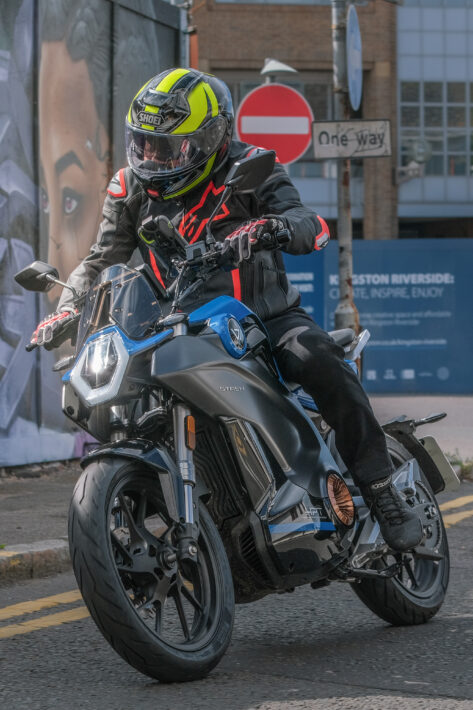
The super-skinny profile and good steering lock helps you slip through the busiest traffic with ease, while the naked bike riding position is commanding and relaxed. And those brakes are strong and progressive, with the safety net of excellent grip from the Pirelli tyres, and ABS to catch any remaining mishaps.
There are just a couple of let-downs in terms of the chassis. The front end feels very harsh over bumps, with some nasty-sounding clashes and bangs as the wheel hits a speed hump or pothole. That’s not unusual on basic suspension setups, but you’d hope for better here.
The other issue is ground clearance. The Stash has a really low seat height (claimed at 810 mm but feels lower to me), which is great for getting both feet flat on the deck, even for a 5’8”/172cm bloke like me. But the pegs are mounted low as well, and you only get very minimal lean angle before they start to deck out, hard.
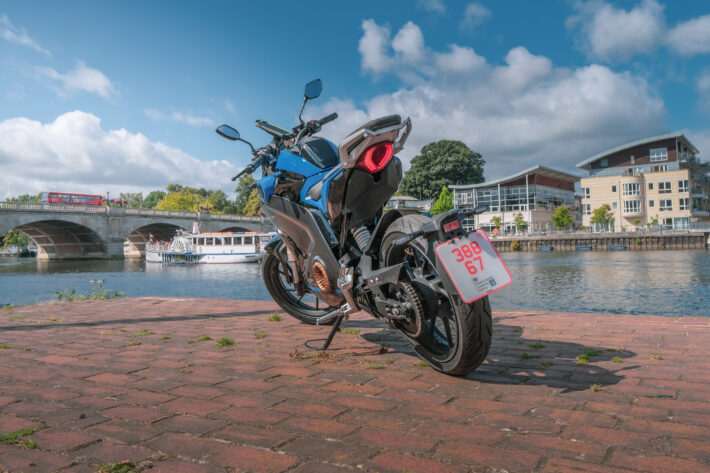
You’d get used to it of course, and there’s no exhaust pipes or frame rails down low, so nothing solid should deck out. But it’s enough to put you off too much lean on your favourite roundabout.
I’ve only done about 25 miles, though the weird start-stop riding on a photoshoot means the battery charge level has halved. That night, I charge the Stash back up to full, and next day I stress-tested it on the A3 dual carriageway down towards the M25 and back.
A couple of runs up and down at absolutely full throttle (78mph on the clock comes up quite quickly) soon runs the battery charge down (after about 30 miles I’m down to 40 per cent from full). But that’s to be expected, and the Vmoto actually did pretty well considering I was actively trying to kill the battery as fast as possible.
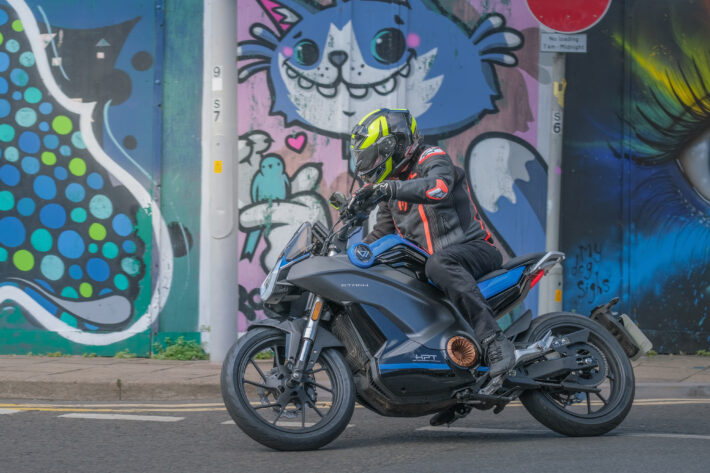
At speed, the Stash is stable and comfy enough for a naked, with a little bit of wind protection from the headlamp surround when you crouch down. Acceleration is steady as the speed increases of course, and like a 125cc bike, you’ll need to plan overtakes of 65mph trucks carefully.
There’s a ‘Boost’ button the left hand bars that supposedly gives you an extra bump of power for acceleration, but I couldn’t seem to get it to work properly – operator error no doubt. What did work well was the cruise control – a nice little extra gadget that is always handy in average speed zones and the like.
So – a couple of days with the Stash reveals a strong, smooth, torquey powertrain for the class, that works really well in urban conditions, and is more than adequate for 70mph dual carriageway work as well.
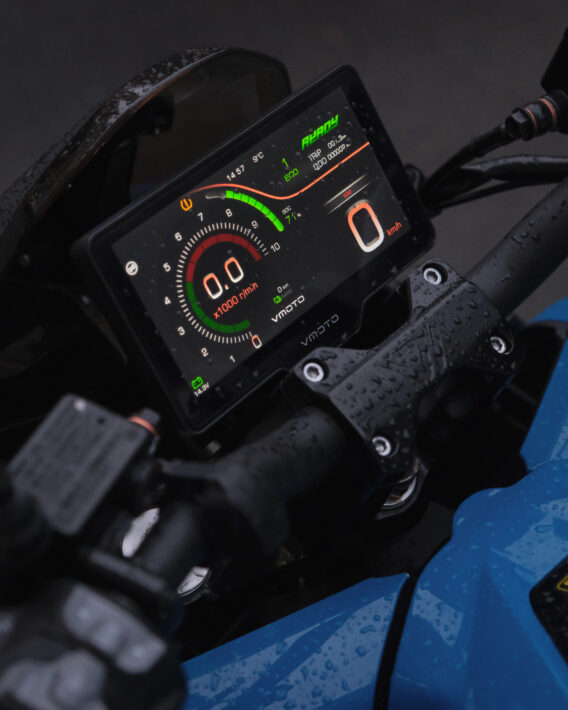
The chassis could do with some work on the harsh front end, and the ground clearance would benefit from some attention too. It didn’t quite convert me from petrol: I had one job to do where I needed to get to Farnborough, around 40 miles away down the A3/M25/M3.
In theory I could have done it in one charge there and back, but would have liked a top-up charge en route. I’d have had to bring the (large, heavy) external charging unit, and found a 13 amp socket etc – so I took the Indian FTR1200 test bike I had parked next to the Stash.
That’s mostly a problem with me and my mindset though, and I reckon if I had a couple of weeks to really get into the Stash groove, a medium-distance trip like that would be no problem at all.
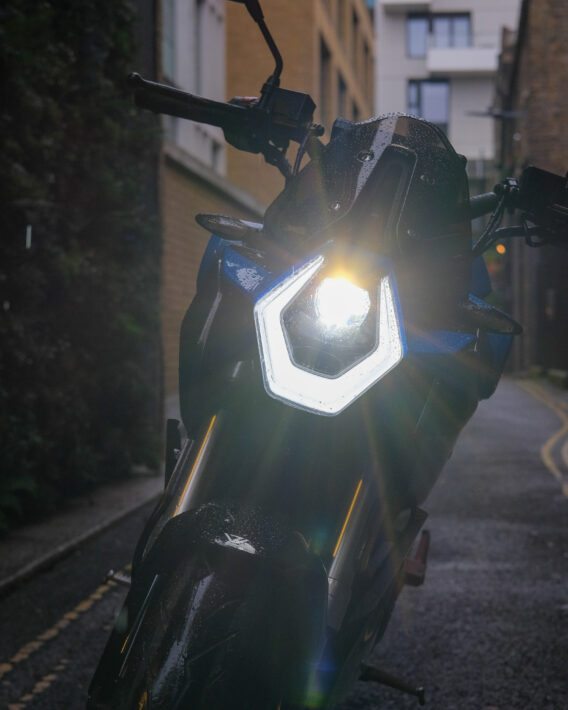
As it is, if you have a daily commute of maybe up to 40 miles, with a bit of motorway or dual carriageway, the Stash would be better than fine.
Get a second charger at work and you could easily do 50 miles plus. It’s pricey up front at around £6500, but the already-cheap running costs of a 125 class bike are slashed even further with electric power: there’s almost no powertrain servicing needed, you might get free workplace charging depending on your employer (there’s no tax penalty for electric vehicle charging at work either), and you’ll have low-cost overnight charging if you have the correct tariff at home.
More info: www.vmoto.co.uk
Vmoto Stash specifications
Price: £6,299 (launch price, August 2024)
Engine: air-cooled motor, single gear, chain final drive
Max power (claimed) 19.4hp peak/12bhp continuous
Battery: 7.2kW/h, 74v, 97Ah
Charge time: 5.5 hours@1.7kW (0-100%)
Frame: steel tube
Front suspension: USD forks
Rear suspension: Preload adjustable monoshock
Brakes: single disc, four-piston radial caliper (front), single disc, single-piston caliper (rear), ABS
Wheels/tyres: Pirelli Diablo Rosso/cast aluminium, 100/80 17 front, 120/70 17 rear
Wheelbase: 1,400mm
Weight: 153kg
Equipment: TFT LCD dash, LED headlight, cruise control, ABS, traction control, keyless ignition, three power modes, low-speed reverse drive, smartphone app with tracking, alarm, steering lock, USB charging port.
Words by Alan Dowds
Photo Credit – Tom Higham @tomboombox